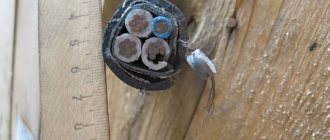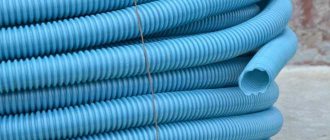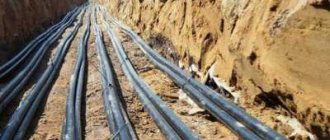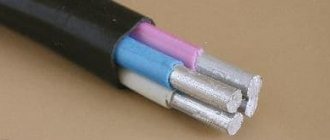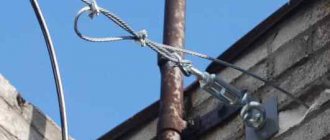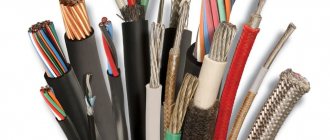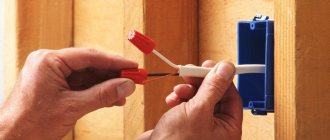Cable installation methods
When laying wiring, an open or hidden method is used. With the first method, all elements of the electrical network pass along the surface of the walls, and with the second, they are hidden in them. An open gasket is considered the most practical and affordable, while a closed gasket looks aesthetically pleasing, but requires a much greater investment of time, effort and finances. As a result, each consumer decides for himself which method to give preference to.
Open cable routing indoors
The open method is the simplest option, requiring protection of the wires from external influences. To prevent the cable from being exposed to moisture, temperature changes, or mechanical damage, several installation methods are used:
- Steel, plastic, asbestos-cement pipes. Steel is the most durable and reliable material, protecting against mechanical damage, electromagnetic radiation, and ignition during a short circuit. Plastic structures are less durable than steel, but have good corrosion resistance and low cost. If the pipes are reliably sealed, they are effectively protected from moisture penetration, even if there is a flood in the room. Asbestos cement pipes are used in industrial conditions for laying wires in poured concrete structures. When choosing elements, pay attention to the material’s resistance to moisture and corrosion.
- Corrugated plastic products differ from ordinary pipes in their flexibility, making them easy to shape into any shape. The absence of additional connecting elements ensures the integrity and tightness of the structures.
- Trays and boxes are used when you need to run several wire lines along one route. Trays are open elements made of plastic or metal that are attached to the walls, similar to shelves, and cables are laid on them. Boxes are closed structures; they are mounted to walls and ceilings. Solid boxes provide reliable protection from external influences, while perforated boxes are lighter and dissipate heat better.
Hidden wiring
Hidden laying is a safe method, but more labor-intensive and expensive. They resort to it when building a house or major renovation, since the method involves placing cables inside walls, floors, ceilings, under finishing materials, in decorative structures:
- Strobes. Markings are made on the surfaces, then the walls, ceiling, and floor are tapped along them with a hammer drill in chiseling mode. The wires are hidden in the resulting recesses without the use of additional elements or using pipes or corrugations, after which they are plastered.
- Floor screed. The laid cable is filled with a special solution or sealed with plaster, and it is advisable to first place the wires in a pipe or corrugation.
- Skirting board. Many decorative elements are equipped with grooves for wires on the inside. Unlike other hidden methods, there is always access to the cable line.
Methods for laying cables outdoors
If you need to do wiring outdoors, for example, in the private sector, in production, two methods are used:
- under water - cable networks are laid in special moisture-resistant structures, using cable brands that are not afraid of moisture;
- underground - they dig trenches at a depth of 0.7 meters, make brickwork for protection or take HDPE pipes (pipes made of low-density polyethylene), there are brands that do not require additional protection.
HIDDEN LAYING OF WIRES AND CABLE LINES
A hidden method of installing electrical wiring is to place it inside building structures, under interior facing elements, or to embed it in the thickness of walls, ceilings or floors.
The laying of conductors can be carried out:
- in existing niches and openings between building structures;
- in specially prepared recesses (grooves);
- into a concrete screed on the floor;
- on the inside of the decorative elements of the room (plinths, fillets, facing panels).
LAYING CABLES IN GROWS
With this installation method, after marking the future wiring route, the walls, floor, and ceiling are chipped along the marking lines. The operation is usually performed using a hammer drill in chiselling mode. After preparing the recesses of the required size, the wiring is laid in them.
Cables can be laid in the wall directly into grooves, or after preliminary pulling into a pipe or corrugation. If necessary, the wiring is fixed in grooves during the installation process, after which the recesses with the cable are plastered.
The installation method in a groove allows you to completely hide the wires without causing aesthetic damage to the interior of the room. On the other hand, repairing and replacing electrical wiring done in this way involves the need to hammer out the walls again.
LAYING THE CABLE INTO THE SCREAD UNDER THE FLOOR
This installation method is used not only for special heating conductors of underfloor heating, but also for conventional electrical wiring.
When placing conductors in a concrete screed, it is advisable to first place them in a pipe or corrugation. When using this method, as when embedding into a wall, difficulties arise with subsequent repair or replacement of wires.
When choosing installation methods involving filling the cable with mortar or embedding it in plaster, you should use only high-quality conductor products, avoiding connections of current-carrying conductors in the embedment.
CABLE ROUTING IN THE PINBOARD
Some types of decorative plastic skirting boards have special grooves on the inside designed for mounting wires for various purposes. This could be an electrical power cable, a telephone line, or an antenna or computer network cable.
The convenience of this installation method lies in the fact that it combines the advantages of hidden wiring and the availability of the cable if it needs to be replaced.
© 2012-2022 All rights reserved.
The materials presented on the site are for informational purposes only and cannot be used as guidelines or regulatory documents.
Cable laying rules
When laying cable lines, you should adhere to a number of recommendations:
- All turns are made only at right angles.
- Electrical networks are laid strictly horizontally or vertically.
- It is better to avoid crossing wires (if this is not possible, use electrical tape and maintain a distance between elements of at least 3 mm).
- The distance to the floor and ceiling should be at least 15 cm, to window, doorways, corners - more than 10 cm.
- The gap between the cable and the heating pipes is at least 3 cm.
- The wire is connected to the switch from top to bottom, and to the sockets - vice versa.
The rules will help you find hidden wires in the wall, as well as plan new cable lines.
There are many ways to lay electrical networks. The choice of method is made according to the personal preferences of the owner. The main thing is to use high-quality materials and components, follow safety rules during installation.
ADVANTAGES AND DISADVANTAGES OF THE HIDDEN METHOD
Hidden wiring includes all power lines laid inside foundations, walls, ceilings and other structural elements of buildings and structures.
When choosing this option, the electrical cable is laid in one of the following ways:
- with laying in pipes and boxes with subsequent finishing with decorative materials or hiding in the voids of structures;
- with laying in pre-prepared grooves, followed by plastering or covering the cable fixed on the surface with at least a 7 mm layer of plaster;
- by embedding in a screed or inside building structures during pouring or erection.
Methods for laying and closing cables in wall channels depend on the materials of the supports and walls; especially stringent requirements are put forward for houses made of wood and its derivatives. In this case, laying electrical wiring in grooves (relevant when laying power lines in houses made of concrete and brick) is abandoned in favor of cladding made of non-flammable materials.
The cable is protected whenever possible by rigid channels and pipes, special attention is paid to areas of passage through wooden walls.
When choosing gating, the emphasis is on the correct preparation of the channels, namely: laying a 2-3 mm margin in depth and width, controlling horizontal and vertical.
The power line laying scheme is thought out in advance and implemented without deviations; the final hidden wiring plan is saved for subsequent repairs. Immediately before closing the gate with the electrical cable, it must be cleaned of construction dust.
Conductors poured with concrete are protected by corrugation or rigid pipes; whenever possible, the installation of taps in monolithic structures is avoided.
If the concrete thickness is sufficient, the method of fixing protective covers in horizontal screeds does not matter; in vertical elements, the use of additional fasteners is mandatory.
The cable hidden in hollow and frame partitions must be insulated and tied to the sheathing nodes. Relaxations are allowed only in the case of wiring in the longitudinal voids of factory reinforced concrete floors.
Deviation from right angles during hidden installation is unacceptable; the more carefully and in detail the layout plan is thought out, the better. The quality requirements for cable insulation and accessories are also high; using cheap materials with this method is not recommended.
The integrity of the electrical wiring is checked at least twice - before installation and after hiding in grooves or channels.
The advantages of the hidden cable laying method include minimal separation of sockets and switches on the walls and complete masking of the power line. The surface of the walls and ceilings remains free, nothing interferes with the finishing work.
The disadvantages of hidden installation are associated with the lack of the ability to visually monitor the condition of the cable; it is difficult to find an electrical line in a room without a plan for its wiring. Work that affects the integrity of building structures poses a serious threat to the electrical cable; repairing old lines or expanding them becomes more difficult.
Open wiring:
1. On insulators, as well as on rollers.
2. Directly on the surface of walls, ceilings and on strings, strips and other supporting structures.
3. On trays and in boxes with openable lids
4. In metal flexible sleeves
5. In steel pipes (ordinary and thin-walled) and blind steel boxes
6. In non-metallic pipes and non-metallic blind boxes made of fire-resistant materials
Hidden electrical wiring:
1. In non-metallic pipes made of combustible materials (non-self-extinguishing polyethylene, etc.)
2. In closed channels of building structures
3. Under plaster
4. In metal flexible sleeves
5. In steel pipes (ordinary and thin-walled) and blind steel boxes
6. In non-metallic pipes and non-metallic blind boxes made of fire-resistant materials
As you can see, on any fireproof structures and inside them, it is allowed to install wiring using all available methods. You can simply lay VVGngLS brand electrical cables directly along the wall or ceiling, attaching them to nylon dowel clamps. This is the fastest and easiest installation method.
In modern apartment buildings, the overwhelming majority of foundations and structures are fireproof. These are concrete or monolithic ceilings and floors, as well as walls made of brick, foam block or tongue-and-groove gypsum slabs.
At the same time, the use of protective PVC corrugation is NOT REQUIRED; you can read more about this here.
Laying in cable channel
The method is used for laying lines consisting of more than 6 electrical wires. Channels are made of brick or reinforced concrete in the form of wall slabs and trays of different sizes.
Advantages:
high degree of protection of lines from damage; carrying out inspections and repairs without the cost of additional excavation work.
Flaws:
difficult air exchange and heat removal due to the limited size of the channel; the possibility of mutual damage to cables when an arc occurs; the need to open the upper channel cover during inspection or repair.

